When Ro McGonegal sent us a story about John Kaase Racing Engines building their new Boss 9 engines for hot rods, muscle cars, and street rods, we were intrigued. Having driven a real life Boss 429 Mustang I can tell you that these things are bitchin beyond bitchin but they are also unruly on the street. Kaase’s are supposed to be driveable, and are available from 429 inches on up to 605. We’ll take the 605 please. Check out Ro’s story and build photos below.
Kaase’s New Boss Nine hemi for street rods and street machines
Ro McGonegal
Undoubtedly, Ford has produced some of the most exotic engines in car junkie history. None of them exist today in their original form, but one of them has just been revived, just as cool, just as intimidating, but with a soul and a disposition for modern times.
The biggest negative about the original Boss 429 engine was the size of the intake and exhaust ports. Their volumes were so large they didn’t produce viable velocity until the airflow reached the upper rpm band. In short, it was an homologation special built to satisfy minimum production numbers in order that it be legal in certain racing organizations.
Jon Kaase Racing Engines in Winder, Georgia, husbanded this remnant a few years back and decided to go full steam and make the Boss Nine fully effective for street and recreational duty. For aspiring engine builders, Kaase supplies all the parts needed to build a Boss Nine or alternatively they’ll provide a fully assembled dyno-tested unit. In the case of a street rod or vintage street machine, they offer a trio of cylinder blocks from which to choose: stock Ford 429 or Ford SVO cast iron or Ford SVO cast aluminum.
Though more expensive the advantage of a cast aluminum Boss Nine engine is that it weighs much less than its cast iron counterpart. It also features ductile iron cylinder sleeves that are pressed into the alloy block. This formula removes the threat of coolant in the water jackets making contact with the cylinder liners thus eliminating certain corrosion troubles. To build cost-effectively, the production passenger car 429 cylinder case is the answer. With a 0.030-inch overbore and a 4.300-inch stroke crankshaft (Scat has an over-abundance of these particular units) the tally becomes 520 cubic inches. Another plus for the BB Ford is that the crankshaft has sufficient clearance to allow a long stroke to function without altering the location of the camshaft, even with a 4.50-inch stroke or 600ci.
JKRE offer the following stroke lengths: 3.850, 4.125, 4.250, 4.300, and 4.500 inches. Though the popular cylinder bore choice is 4.390in they go larger. This is accomplished by Ford’s SVO aftermarket blocks that have the capacity to provide 4.600in bores. These bigger blocks feature siamesed cylinder cases—there are no water jackets between the cylinders—and cooling is effected on the inside and outside flanks. Indeed, displacement tops out at 605ci, but the most popular combination is one for 520 or 528 cubic inches. Oiling is available in wet or dry sump configurations, but street runners usually forgo the dry sump arrangement because it adds complexity and avoids the vagaries of public roads (a stone wedged between drive belt and pulley, for instance). Nonetheless, a dry-sump system adds 40 horsepower to the total versus a wet arrangement. The wet sump features a one-way mesh screen bolted to the sump, a ¾-inch wide metal scraper mounted at the top of the mesh screen and running the length of the screen, and two one-way trap doors in the sump itself that maintain a deep reservoir of oil around the pick-up during hard braking.
Because original Boss hemi heads are as scarce as lips on a chicken, Kaase opted to produce his own, infusing them with modifications for increased drivability, low-end response, and a tranquil 700-800rpm idle speed. The heads have a ¾-inch thick deck surface that will easily accommodate very high compression or whatever power adder spins your bow tie. Once the fine-tuning is accomplished, the 528-inch engine will produce whatever power output you desire. Most enthusiasts opt for performance between 450hp and 800hp on pump gas—more than enough ‘crank’ to blow your bantam-weight three-window into the middle of next week.
Adjunct to the revamped cylinder heads, the miracle of technology runs rampant in the camshaft department. Be aware that camshaft duration must not go beyond 240 degrees lest manifold vacuum be severely compromised and require a booster or canister to retain it. Kaase’s Boss Nine depends mostly on the lobe separation angle and multi-phased hydraulic roller camshaft that foments low-speed response as well as a smooth transition from idle speed to fully open throttle, as is perfect for chugging through town or idling merrily around the show-ground venue.
Mounting the Boss Nine can be done either by a motor plate (to make the drive train angle as straight as possible) or with usual mounting hardware. The front of the standard Boss 429 engine sits four degrees up, with a corresponding angle on the manifold boss to keep the carburetor base horizontal. Induction choices are plentiful, ranging from the usual single 4-barrel (4150 or 4500 series) on a single-plane intake, a tunnel ram set-up, a roots-type supercharger, Hilborn stack injectors, or a Wilson 1388cfm 4-barrel throttle body injector, as shown here.
Back in the day, two Boss Snake prototypes were built at Kar Kraft’s Brighton, Michigan, facility, using the Boss 429 body, the front clip (minus the scoops) and tail lights and exhaust treatment from a Shelby GT500, and a Cougar dashboard. Kar Kraft, you may remember, is the same outfit that raised the 427 Thunderbolt drag cars.
Realize that the images and captions that follow depict rudimentary forms, not a how-to manual. You will recognize both the cast-iron and the aluminum block.
When machining operations are finished on the Boss Nine bare block it is washed with mineral spirits and internal bores and galleys are cleaned with a long-handled wire brush. It is then washed with hot, soapy water and dried with compressed air. Next, coated rod and main bearing shells are put in place in which a forged steel crankshaft will operate.
An advantage of the big-block Ford is that it has sufficient clearance to allow a long-stroke crank to function without altering camshaft location. Crankshaft end play should measure between 0.004-0.007-inch.
Main caps are secured by ½-inch Grade-ten bolts or studs (if aluminum) and torqued to 100 lb-ft. To deter oil leaks, one end of the main seal protrudes above the pan rail surface while the other end is below; in the bearing cap the seal is placed vice versa. In this way the staggered ends prevent leaks.
Like most Boss Nine engines, this one receives a hydraulic roller. Here the cam is being lubed prior to careful insertion in the cylinder block. The copper-coated core indicates this nickel chrome moly cam has hardened journals and cam lobes.
Kaase’s experience has taught him all the engine’s weak points. This special drilling jig is used to make another hole for an additional dowel in the timing gear. This phase ensures that valve train loads are reliably transferred from the crankshaft to the camshaft.
The cam is first clamped in a vise. The timing gear uses the original dowel. Then a second dowel hole is drilled, reamed, and transferred to the camshaft. To complete the strengthening process between camshaft and timing gear, JKRE drills and re-taps the original 3/8-inch diameter hole to accept a 7/16-inch retaining bolt.
This Woodruff key is responsible for locating the timing gear. Here it is being tapped into place with a brass drift. The harmonic balancer is driven by another Woodruff key (hidden) further toward the end of the crankshaft.
The crankshaft pulley for the double-roller chain is machined with a series of Woodruff key slots that allow valve timing to be advanced or retarded by 2, 4, 6, or 8 degrees.
Diamond forged pistons are secured to the connecting rods with Trend H-13 wrist pins. Rings are installed thusly: lower support rail for the oil controller, oil controller followed by the upper support rail, the second ring, and finally the top ring.
You can never have too much pre-lube. Pistons are coated with engine oil prior to installation in the cylinder bore. Using 2618 low-silicone forgings Diamond provides custom pistons for all Kaase Boss Nine engines.
Great care is taken not to nick or score the crankshaft journal with the big end of the rod. The rod bearing caps are secured with 12-point Grade 10 fasteners and tensioned to 75 lb-ft.
The shape of the Boss Nine hemi combustion chambers and the angle of its valves make it very efficient, producing easily 100 horsepower more than an equivalent Wedge-style head. The valves are never shrouded by the chamber or the cylinder walls.
In the Kaase hemi head both incoming and outgoing gases travel a straight path. Because the valves open into the middle of the cylinder, the intake charge is delivered centrally where the spark plug is located. The exhaust gases, too, have an easier exit path.
Prior to the torque sequence, silicone sealer is swabbed on both sides and ends of the gasket around the oil drain-back holes. Boss Nine heads are secured by ten 12-point Grade 10 fasteners that are torqued to 75 lb-ft.
Kaase sources his rocker arms from WW Engineering in Dawsonville, Georgia. They are hewn from aluminum billet, afford a ratio of 1.75:1 and are the same stock that JKRE uses on all 820-inch IHRA race motors.
Taken directly from its box, and without further porting work, Kaase’s single-plane intake manifold has flowed sufficient air to sustain 1130 horsepower. Moreover, on an engine as small as 429cu in, it has supported full engine loads at 2300rpm. These intakes accept 4150- or 4500-style carburetors as well as Wilson throttle body fuel injection systems.
All Boss Nine engines are dyno tested with all accessories in place to get a truer indication of the engine output. Many shops (and magazines) conduct this test with no accessories, thus inflating the figures.
Kaase single-plane intake manifolds perform brilliantly with Wilson’s new fuel injection systems. Using their patented D-rails, their four-barrel throttle body, and with fuel injectors placed precisely in the intake tracts, the system flows an impressive 1390cfm. The throttle body houses four 2in throttle blades.
Looking beyond the horizon, Kaase leans on the stick and buzzes this 520 Boss Nine—a hemi engine that receives rave reviews from all those who’ve encountered it. Editor’s Note: We don’t know how Kaase isn’t permanently stuck in this position, because he is known for being one of the most dyno intensive engine builders around. Plus, running stuff on the dyno is like therapy for him.

















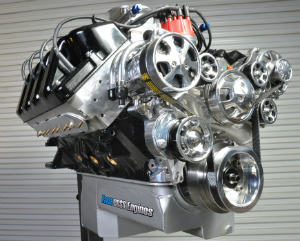


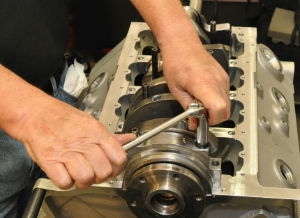
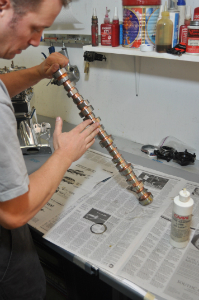
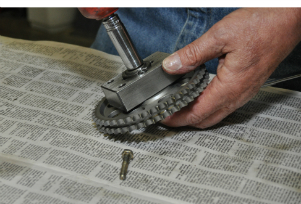

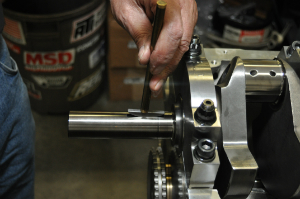
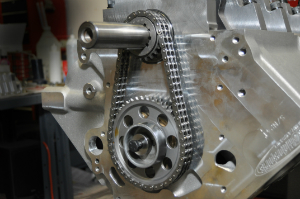
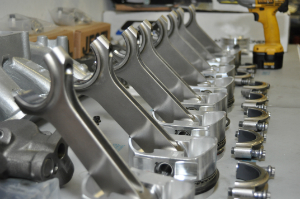
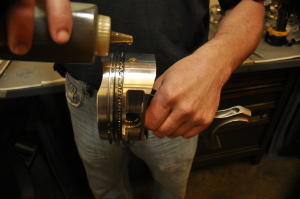
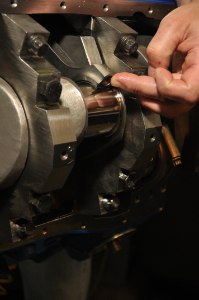

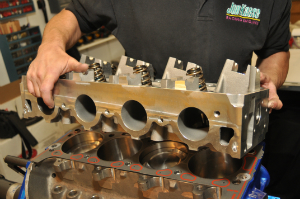

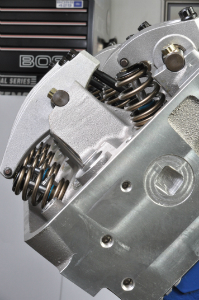
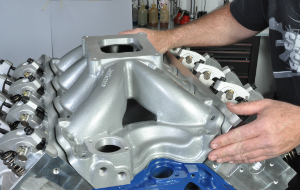
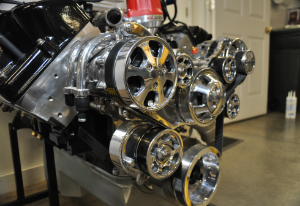
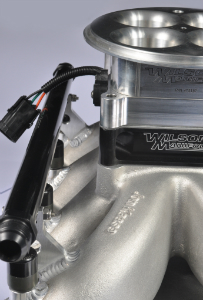






For sale one low milage left nut , proven performance, one kid only. need to sell to buy boss nine motor for ranchero.
Whats the starting price on one of these?
How cool is it to have a Ro Mc story on Bang Shift, and about Boss 9’s no less! Unruly on the street? Those motors are pussy cats. 240@ .050 is an RV cam at 520″.
Just wish to say your article is as astounding. The clarity in your post is simply great and i could assume you’re a professional on this subject. Well along with your permission let me to take hold of your feed to stay up to date with impending post. Thank you 1,000,000 and please carry on the gratifying work.